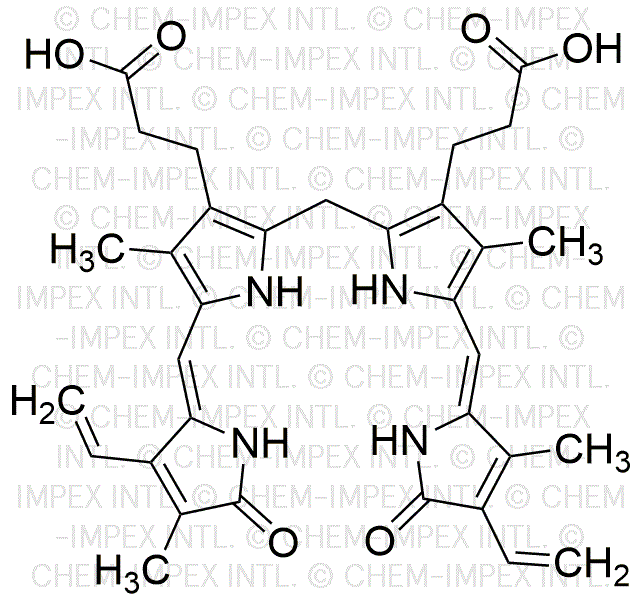Bilirubin is widely utilized in research focused on:
- Medical Diagnostics: It is a key biomarker for liver function tests, helping to diagnose conditions like jaundice and liver disease by measuring bilirubin levels in the blood.
- Phototherapy for Neonatal Jaundice: Bilirubin is used in phototherapy treatments for newborns with high bilirubin levels, effectively reducing the risk of complications from jaundice.
- Antioxidant Research: Its properties are being studied for potential antioxidant effects, which could lead to applications in preventing oxidative stress-related diseases.
- Drug Development: Bilirubin derivatives are being explored in the development of new pharmaceuticals, particularly in anti-inflammatory and neuroprotective therapies.
- Biomaterials: Its potential use in creating biocompatible materials for medical applications is being researched, particularly for wound healing and tissue engineering.
General Information
Properties
Safety and Regulations
Applications
Bilirubin is widely utilized in research focused on:
- Medical Diagnostics: It is a key biomarker for liver function tests, helping to diagnose conditions like jaundice and liver disease by measuring bilirubin levels in the blood.
- Phototherapy for Neonatal Jaundice: Bilirubin is used in phototherapy treatments for newborns with high bilirubin levels, effectively reducing the risk of complications from jaundice.
- Antioxidant Research: Its properties are being studied for potential antioxidant effects, which could lead to applications in preventing oxidative stress-related diseases.
- Drug Development: Bilirubin derivatives are being explored in the development of new pharmaceuticals, particularly in anti-inflammatory and neuroprotective therapies.
- Biomaterials: Its potential use in creating biocompatible materials for medical applications is being researched, particularly for wound healing and tissue engineering.
Documents
Safety Data Sheets (SDS)
The SDS provides comprehensive safety information on handling, storage, and disposal of the product.
Product Specification (PS)
The PS provides a comprehensive breakdown of the product’s properties, including chemical composition, physical state, purity, and storage requirements. It also details acceptable quality ranges and the product's intended applications.
Certificates of Analysis (COA)
Search for Certificates of Analysis (COA) by entering the products Lot Number. Lot and Batch Numbers can be found on a product’s label following the words ‘Lot’ or ‘Batch’.
*Catalog Number
*Lot Number
Certificates Of Origin (COO)
This COO confirms the country where the product was manufactured, and also details the materials and components used in it and whether it is derived from natural, synthetic, or other specific sources. This certificate may be required for customs, trade, and regulatory compliance.
*Catalog Number
*Lot Number
Safety Data Sheets (SDS)
The SDS provides comprehensive safety information on handling, storage, and disposal of the product.
DownloadProduct Specification (PS)
The PS provides a comprehensive breakdown of the product’s properties, including chemical composition, physical state, purity, and storage requirements. It also details acceptable quality ranges and the product's intended applications.
DownloadCertificates of Analysis (COA)
Search for Certificates of Analysis (COA) by entering the products Lot Number. Lot and Batch Numbers can be found on a product’s label following the words ‘Lot’ or ‘Batch’.
*Catalog Number
*Lot Number
Certificates Of Origin (COO)
This COO confirms the country where the product was manufactured, and also details the materials and components used in it and whether it is derived from natural, synthetic, or other specific sources. This certificate may be required for customs, trade, and regulatory compliance.


